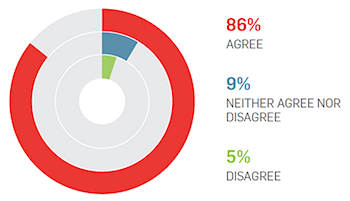We live in the age of the distracted viewer. It’s common for people watching television today to pay little attention to the ads they’re exposed to via the medium, as they’re constantly switching screens and simultaneously engaging with content on a companion device (like checking their phones or their laptop), or fast-forwarding past commercials outright with the use of a DVR. Just because the TV is on, it doesn’t mean anyone’s watching.
Obviously, this distraction only reinforces a lack of TV ad viewership, and presents big challenges for marketers attempting to break through today’s cluttered media landscape.
More than half of TV viewers today — 52 percent — admit changing the channel during a standard network or cable advertising segment, according to a new report on TV viewing habits by advertising technology company Viant Technology.
 To what extent do you agree or disagree with this statement?: “It’s getting harder to grab a consumer’s attention with television advertising alone.” |
The report also found that TV viewers’ screen behavior changes markedly depending on the type of programming they’re watching and the time of day during which they’re watching it. People watching comedy sitcoms are more active on their companion devices than those watching a drama, and TV viewers are more engaged during live sports events than they are while watching either type of those programs. TV viewers are more likely to be active on their companion devices during morning TV shows and during primetime viewing hours in the evening.
Marketers are painfully aware that this disrupted media environment is having a major impact on TV as a stand-alone advertising medium. The Viant report found that 86 percent of marketers believe it’s more difficult to grab a consumer’s attention today with TV advertising alone. Nearly half — 46 percent — blamed the challenge on consumers distracted by competing screens, and 43 percent said “cord cutters” — or those who cancel their cable service in exchange for rival digital TV offerings — are making target audiences harder to reach. Altogether, 82 percent of marketers polled believe companion devices and/or advertising clutter have limited the success of their television advertising campaigns.
As a result of this, more than half of marketers — 57 percent — said they plan to spend the same or less on TV ad spends in 2018 than they did last year.
In order to achieve their goals, the Viant report mentions that marketers can leverage TV consumers’ increasing alternatives to linear TV and implement a cross-device marketing experience to connect with today’s distracted viewers. According to the report, viewers who saw a brand’s ad on TV and were then targeted with a digital ad within a few hours were 72 percent more likely to convert into paying customers within a day.
Viant’s report, “TV Viewability in the Age of the Distracted Viewer,” was based on findings from live TV viewing data from that company’s network of 12 million homes. A survey was also conducted by market research company Censuswide, which polled 500 marketing pros in July based at U.S. companies.
Viant is a subsidiary of Meredith Corporation.


 Abandon traditional content plans focused on a linear buyer progression and instead embrace a consumer journey where no matter which direction they travel, they get what they need, stressed marketing pro Ashley Faus during O'Dwyer's webinar Apr. 2.
Abandon traditional content plans focused on a linear buyer progression and instead embrace a consumer journey where no matter which direction they travel, they get what they need, stressed marketing pro Ashley Faus during O'Dwyer's webinar Apr. 2. Freelance marketers and the companies that hire them are both satisfied with the current work arrangements they have and anticipate the volume of freelance opportunities to increase in the future, according to new data on the growing freelance marketing economy.
Freelance marketers and the companies that hire them are both satisfied with the current work arrangements they have and anticipate the volume of freelance opportunities to increase in the future, according to new data on the growing freelance marketing economy. Home Depot's new attempt to occupy two market positions at once will require careful positioning strategy and execution to make it work.
Home Depot's new attempt to occupy two market positions at once will require careful positioning strategy and execution to make it work. Verizon snags Peloton Interactive chief marketing officer Leslie Berland as its new CMO, effective Jan. 9. Berland succeeds Diego Scotti, who left Verizon earlier this year.
Verizon snags Peloton Interactive chief marketing officer Leslie Berland as its new CMO, effective Jan. 9. Berland succeeds Diego Scotti, who left Verizon earlier this year.  Norm de Greve, who has been CMO at CVS Health since 2015, is taking the top marketing job at General Motors, effective July 31.
Norm de Greve, who has been CMO at CVS Health since 2015, is taking the top marketing job at General Motors, effective July 31.


 Have a comment? Send it to
Have a comment? Send it to 
No comments have been submitted for this story yet.